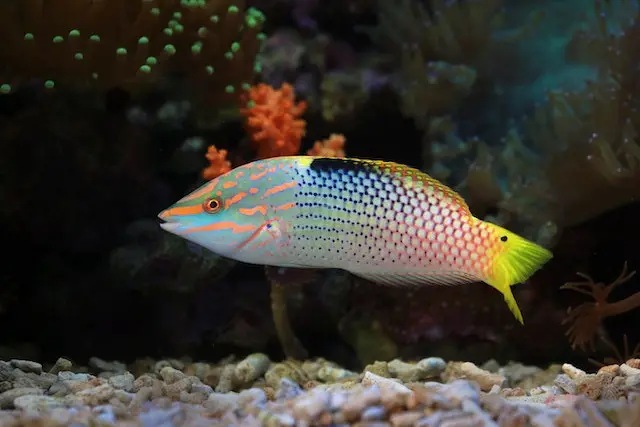Maintaining an aquarium is about more than just pouring in some food so that you can watch the fish you love so much eat.
This is especially concerning a reef tank, which, beautiful as it may be, gives an owner his share of duty.
Ask anyone with reef tanks, and they will tell you all about it. This article, however, will tell you how to raise phosphate in reef tank, preparing you for what you must do and how to solve the challenges that come with it.
What Is Phosphate And Why Does It Matter?

Phosphate, as the name suggests, is a derivative of phosphorus. In other words, one atom of phosphorus and four atoms of oxygen make phosphate.
In an aquarium, this is mainly formed by mineralizing wastes like uneaten food, feces, and dead matter.
It is highly reactive and helps plants in the aquarium to absorb the nutrients better.
How To Raise Phosphate In Reef Tank?
For a healthy aquarium, it is imperative to have the proper levels of phosphate, which can sometimes be challenging.
Sometimes coral can eat up your available phosphate; sometimes, there could be a lack of a stable nitrogen cycle.
Either way, here are some ways to raise the phosphate levels in your aquarium.
1. Adding More Fish Food
Of these, two that are known to work wonders are Nori and Mysis Shrimp. Nori is a seaweed rich not just in phosphate but various other nutrients that a fish needs, like calcium, phosphorus, and other vitamins and minerals.
Mysis shrimp, too, provide many nutrients apart from being a good choice for picky eaters in the aquarium.
2. Activated Carbon
This is another effective way to increase phosphate in a reef tank as it cleans your aquarium, removing unwanted organics and debris.
This can eliminate the need for more frequent water changes. But use this sparingly, for this can lead to the other extreme, high phosphate levels in your aquarium.
3. Powdered Phosphate
Finally, you have a solution in powdered phosphate, which you can dilute in some RO water and then pour into your reef tank.
And how much of this should you add? Consider your aquarium has one liter of water. In that case, one milliliter is all you need. You can now calculate the requirement in your aquarium.
Recommended Reading: Are Fish Happy In Tanks?
What Is A Good Phosphate Level In Reef Tank?
The ideal phosphate for a reef tank is 0.5 to 1.0 ppm. However, some reef tanks have larger coral colonies. If so, you can increase the phosphorus level based on the size of these corals.
Generally, you do not let this phosphate reach a concentration greater than 30 ppb, as this can inhibit the precipitation of calcium carbonate and affect the corals’ well-being.
Signs Of High Phosphate In Reef Tank
How much phosphate is too much phosphate? While this may be hard to determine, your fish and other aquatic life will help you by giving you the signs. The water in your aquarium will do that too.
Learn about each of them here by having a look.
- Algae Overgrowth: One of the first signs here is excessive phosphate is algae growth in your aquarium. This can be very dangerous, for before you know it, this culprit will soon destroy all the life in your reef tank.
- Cloudy or Green Water: Green water is a clear sign of algae blooms in your aquarium, which is a sign of excessive phosphate. While the haziness of the water may not be harmful to the fish, know that it is a sign of something dangerous, which you have to get rid of from your aquarium.
- Reduced Coral Health: Undetachable levels of phosphates and nitrates are one of the many reasons behind the reduced coral health in your reef tank. As you know by now, this results from the corals being starved of oxygen. However, know there are other reasons behind this, too, like the lighting in your aquarium, alkalinity, pH levels, etc. So, check them too but ensure you also check your aquarium’s phosphate levels.
- Poor Growth and Coloration: Among the many reasons, like lighting and pollutants, is the excessive levels of phosphate, which could be the cause in your case. You may notice that the corals in your reef tank are no longer growing as they once used to, and then you may also see that they are less bright and colorful than they once were.
- Fish and Invertebrate Health Issues: This is another one of the sad signs that you have too much phosphate in your reef tank. Excessive phosphate can be deadly to the extent that it can kill your fish, so the minute you notice an infected one, check the levels of this chemical in your tank.
- Increased Cyanobacteria Growth: One mostly finds this kind of bacteria in the water and soil, which means it can be found in your aquarium as a sign of increased phosphate levels. While this may not harm the fish and other living creatures in your reef tank, it can later lower the oxygen level in the water, just like algae does, which means you need to look into it.
And these are some ways to detect what levels are too high levels of phosphate in your aquarium. If you don’t find any of them, you have no cause for worry, but if you spot even one, know that you need to take immediate action, so hurry!
How To Lower Phosphates In Reef Tank?
Too much phosphate can lead to the growth of opportunistic algae, which can deplete oxygen levels in the aquarium. This can cause a significant problem for fish that need this oxygen.
Maintaining an aquarium makes it increasingly necessary to keep the phosphate levels in check. Here are some ways to do it.
- Vacuuming the sand bed: One way to maintain the phosphate level in your aquarium is by keeping the sand bed clean and regularly vacuuming your aquarium sand bed. Sure, there is the work of removing the decor, but make it a routine each week (fortnight, too, will do), and you will significantly reduce the worry of excessive phosphate for yourself and your fish.
- Perform regular water changes: Many find this to be taxing, but this can significantly keep the phosphate in an aquarium in check. So, if you have an aquarium at home, make sure that you change about 10 to 20 percent of the water volume weekly. This will not just check the level of phosphate but also get rid of unwanted toxins.
- Use a protein skimmer: Protein skimmers are filtration devices that work as a good supplement in aquariums, as they effectively rid your aquarium of all the excessive organic wastes from the aquarium.
- Add macroalgae: Macroalgae are an effective form of natural filtration, thus keeping the water stable. They are easy to maintain, serve as a nice decoration, and remove excessive phosphates and nitrates from your aquarium.
- Use GFO: GFO stands for Granular Ferric Oxide and is a reddish brown powder that significantly helps absorb the extra phosphate in an aquarium. Besides, it also inhibits algae growth to protect your coral reef from getting destroyed by it. Most will come with usage instructions so you won’t struggle with it.
- Liquid removers: Finally, you have liquid removers, which you can easily add to your aquarium to have them eliminate the reactive phosphate present in excessive quantities in your aquarium. Don’t worry. It is safe and will not harm your aquarium’s fish or plants.
Top 3 Best Phosphate Remover For Reef Tank
You have seen enough about the harms of excessive phosphate in your aquarium, how to detect its presence, and what you can do once you notice too much of it.
And with all that on your mind, you are now on the lookout for an effective phosphate remover, and so for all of you, first-time aquarium owners, here are some of the best ones out there for you.
1. Seachem PhosGuard Aquarium Phosphate Remover
Made with alumina oxide, this one works rapidly, removing phosphate and unwanted silicate from your water column. It is easy to use and considered safe for the fish too.
This one is not affected by water hardness and is thus a good choice for those living in areas with hard water too.
2. Fluval ClearMax Phosphate Remover
This is a premium-grade resin chemical filter media that again removes not just unwanted phosphates but nitrates, which can be harmful and toxic to fish too.
Besides, it does an excellent job of ridding your tank of algae and giving your fish crystal-clear water to swim in.
3. Kolar Labs GFO
This form of granular ferric oxide works effectively not just in keeping the aquarium pure and free from high levels of phosphates but also helps improve aquatic life.
It is also harmless and easy to use, making your aquarium more presentable by improving coral coloration, so much so that this will be one of your favorite products for your aquarium.
While there are several more available out there, these are the best and most effective that you can get, so choose the one that would be best for you.
Must Read: Pompano vs Jack Crevalle
How Does Phosphate Affect Fish?
One of the most significant ways phosphate can affect fish is (as you would have seen above) reducing the oxygen in the environment, contributing to algae which will use up all the oxygen present and starve your poor fish in the long run.
Additionally, it can affect the water in your aquarium, reducing its quality and introducing toxins that are harmful not just to the fish around but to the aquatic life in your aquarium too.
What Is The Best Phosphate For A Reef Tank?
The best phosphate is one with a level that ranges anywhere between 0.5 to 1.0.
Apart from that, phosphates are a natural product resulting from waste in your tank through food, excrement, and other decaying living creatures in the tank.
All of them can effectively regulate the life in your tank as long as the levels are kept in check.
Final Thoughts
In summary, while phosphate in an aquarium is much needed and suitable, more is required. Knowing how to raise phosphate in your reef tank is one of the first tasks for you, and then considering all that you’ve learned above to maintain this level and keep it in check, for in the end, you don’t want a chemical in your aquarium being an unwanted nuisance for you.
This may be some work but think about the beautiful and clear aquarium you get to see in the end due to your hard work. What’s more, the fish that you love so much will be happy too.
Frequently Asked Questions: How to raise phosphate in reef tank?
Let us now end by answer a few questions for you:
Q1. Should Phosphate Be Zero In Reef Tank?
Ans: No, as said above, the ideal phosphate level in a tank should be between 0.5 to 1.0 ppm. This is because a reef tank with a small amount of phosphate helps preserve the life of the coral species, giving them the right color and helping in tissue growth. What’s more, it supports the life of aquatic animals similarly, too.
Q2. How To Raise Nitrates In Reef Tank?
Ans: The easiest way out is to feed the fish in it more. Add some more fish if you have to. This way, you will produce more waste in the tank, thus giving the corals more nitrates.
Q3. How To Raise Nitrate Without Raising Phosphate?
Ans: This one can be tricky, but here’s a way to go about it. If you try the above method, you will add nitrates and phosphates, so don’t feed the fish. Instead, use a nitrate supplement, as this will increase only the nitrates without increasing the level of phosphate in the water and destroying your fish.
Q4. How To Increase Nitrates In Aquarium?
Ans: Potassium nitrate is the best way to go about this, but make sure that you add a decent dose and don’t go overboard with it. Apart from increasing the level of nitrates in your aquarium, this will also provide the required amount of potassium and nitrogen to the plants in it.



